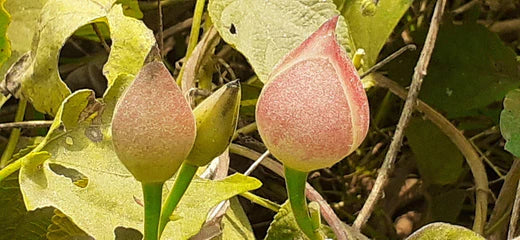It is a milky-colored creeper that is evergreen and aromatic. The robust, brown, twinning, and tall stems are twisted. There are a lot of tiny, oval-shaped leaves. The plant has three to four branches and one to four-inch-long white flowers. Round-shaped fruits contain lustrous, two-inch-long seeds. Thick, branching, and dark-colored roots. The roots are tall, thin, fleshy, and heavily branching. They have a black tint. March to December is when the plant produces its fruits and flowers.
General Information
Trivrit is classified as one of the most highly helpful herbs in Ayurveda. Because this plant has so many purgative qualities, it helps in the body's detoxification. Antipyretic and anti-inflammatory qualities abound in this herb. Because it helps clean the stomach, using this plant is beneficial for liver diseases. The herb helps with a number of issues, including irregular bowel motions, hemorrhoids, constipation, and gas.
Ten percent of the glycosidium resin is found in the root bark. Additionally, it contains turoethin, a glycoside with purgative properties. Aside from this, it also includes two glycosides, which are volatile oils with medicinal properties.
Classification
- Kingdom: Plantae
- Division: Magnoliophyta
- Class: Magnoliopsida
- Order: Solanales
- Family: Convolvulaceae
- Genus: Operculina
- Species: O. turpethum
Habitat
In India, this herb is frequently found on the sides of the road. This hairy, perennial herbaceous vine is native to India and can reach a length of 4 to 5 meters. The herb is typically found up to 3000 feet in the Deccan and North Circars regions.
Names
- Latin Name - Operculina turpethum
- Sanskrit Synonyms - Rechani, Ardhachandra, Kumuda Gandhini, Tribhandi, Triputa, Trivrit, Sarala, Suvaha.
- English Name - Transparent wood rose, Turpeth root, India Jalap, Saint Thomas Lidpod
- Hindi Name - Panila, Pithori, Nisoth
- Telugu Name - Tegade
- Bengali Name - Tevudi
- Marathi Name - Nisottar, Nishottar
- Gujarathi Name - Nasttara
- Tamil Name - Kumpncan, Paganrai, Sivadai, Adimbu
- Malayalam Name - Chivaka
- Kannada Name - Devadanti, Nagadanti, Vilitigada, Aluthi gida, Bangada balli, Bilitigade.
Ayurvedic Properties
|
|
Hindi / Sanskrit |
English |
|
Rasa (Taste) |
Tikta, Katu |
Bitter, Pungent |
|
Guna (Physical Property) |
Ruksha, Tikshana, Laghu |
Dry, Sharp, Light |
|
Virya (Potency) |
Ushna |
Hot |
|
Vipaka (Post-Digestive Taste) |
Katu |
Pungent |
Effects on Doshas
Pitta and Kapha doshas are balanced by it. Likewise raises the Vata dosha.
Classical Categorization
|
Charak Samhita |
Sushruta Samhita |
Vagbhata |
|
|
|
Practical Uses
- This herb has several purgative and cleansing qualities. It facilitates smooth stool passage and promotes regular bowel movements. Additionally, the herb aids in preventing constipation.
- Using this herb helps to effectively treat hemorrhoids. Hemorrhoid symptoms like itching, irritation, redness, soreness, and swelling around the anus might be relieved with its assistance.
- This herb is well-known for being effective in treating edema because it aids in the body's removal of excess water. Additionally, it aids in the management of symptoms including stretched skin, an increase in the size of the abdomen, and puffiness or swelling of the tissues beneath the skin.
- The plant is also beneficial to liver health. By eliminating toxins, it helps in the liver's cleansing process.
- This herb's purgative properties are particularly helpful for a number of gastrointestinal issues, including indigestion, flatulence, and irregular bowel movements.
- This herb also supports the body's ability to maintain normal cholesterol levels.
- Because of its purgative properties, this herb is beneficial for treating osteoarthritis and arthritis. It helps in lowering joint swelling and inflammation. Additionally, its anti-inflammatory qualities aid in the lessening of pain.
- This herb's abundance of anti-diabetic qualities contributes to the maintenance of the body's normal blood sugar levels. Additionally, this herb helps in the management of diabetes-related symptoms such as weariness, increased urination, weight loss, excessive thirst, blurred vision, and sluggish wound healing.
- Because of its antipyretic properties, it helps in reducing fever.
- Treatment of respiratory issues such as cough, bronchitis, dyspnea, pneumonia, and tuberculosis can be greatly aided by the use of this plant. It facilitates the removal of mucus from the airways. Additionally, the plant relieves coughing, nasal congestion, lung congestion, and shortness of breath.
- This herb's blood-purifying qualities are particularly helpful in treating skin conditions. It helps to relieve the burning, itching, redness, and oozing sensations, among other symptoms connected to skin disorders.
- This herb's anthelmintic qualities help in the body's removal of intestinal worms. Because of this, using this herb to treat a variety of intestinal illnesses caused by bacteria, viruses, protozoa, and other pathogens that can cause major digestive issues like cholera is highly effective.
- This herb's anti-inflammatory properties help in relieving the body ache.
Parts Used
Roots, Bark, Leaves.
Dosage
One to three grams of powder, divided daily.

